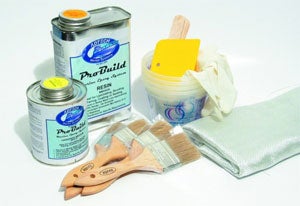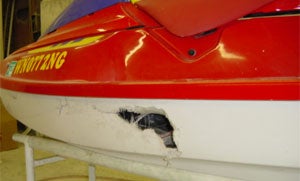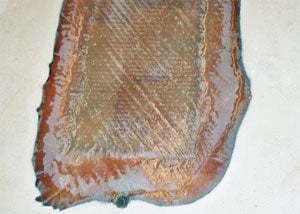How to Repair Personal Watercraft Hull Damage
Now is the time to repair your PWC
Winter is not the ideal season for the personal watercraft enthusiast, but the downtime does present opportunities. One obvious is the chance to repair any hull damage that may have occurred over the summer so that you’re ready when the season rolls back around.
Sound daunting? It is for many of us. Professionals should probably handle serious damage. But even the most minimally skilled PWC owner can repair smaller cracks or holes if they follow the right steps and use the right materials. Here’s a primer:
Day 1:
Tool Up
 A repair kit like this will get you started on minor hull repair.
A repair kit like this will get you started on minor hull repair.Before you even start, it’s essential to gather together the tools you’ll need for the job. In the case of most fiberglass or SMC (Sheet Molding Compound) repair jobs, that means an epoxy resin and hardener, fiberglass cloth, mixing cups, a small paintbrush, a plastic scraper, acetone to clean the surface, and rubber gloves to protect your hands. Sandpaper is also a must (try #80 for the rough work, and #220 grit for finishing), and a small file, or Dremel tool, to help with any trimming and cleaning.
Initial Steps
Make sure you’re working in a well-ventilated area. Protect your eyes with safety goggles, and your hands with gloves. When you’re well protected, start to work on your craft.

The basic idea to fixing a hole or crack is to first remove all of the crushed or splintered hull material so that you’re back to a solid surface. Try the Dremel tool or coarse file to remove all the damage. With the crack or puncture removed, next feather the edges of the resulting hole outward with #80 sandpaper, so that you bevel the surface. The goal is to increase the surface area for the resin mixture to form a secure bond. Continue to sand away from the edges to form about a two-inch perimeter around the hole, removing the paint and exposing the raw material below. Clean up the dust, along with any oil, grease, or residue with acetone and allow to dry.
Prepare The Patch
Although it’s tempting, don’t rush the repair. Plan out how you’ll do the job, and go through a test run before mixing any fiberglass. One proven method is to use a solid backing layer of fiberglass cloth secured behind the hole, working from the inside, and then to build up the damaged area from the outside in multiple layers. Cut two sections of the inside cloth so that it overlaps the hole by about 2” on all sides. Next, cut numerous pieces of cloth that roughly fit the hole, some exact, some with a small overlap.
Mix It Up
Check out the instructions that came with your fiberglass repair kit or supplies. Resin and hardener will solidify fairly quickly once mixed together, so mix together a small batch initially. Using the brush, spread a little of this mixture around the perimeter of your hole from the inside, then stick the interior “backing” piece in place by pressing the edges into this wet surface. Avoid letting this backing patch pucker out into the hole; instead, keep it as taut and flat as possible.
Brush more resin and hardener mixture onto the cloth until it is completely saturated. You don’t want it to be a drippy mess; instead, just make sure it’s soaked through. As an alternative, you can wet the cloth before putting it into position as well, just be aware that it will be slightly harder to work with.
Brush And Repeat

Use the brush, or your plastic scraper, to carefully remove excess resin and eliminate any air bubbles you see in the repair. Properly saturated fiberglass cloth or mat looks wet and shiny, and almost clear, with the weave of the cloth still slightly visible. Repeat the process with a second piece of backing material, then set everything aside for the night and allow it to fully harden.
Day 2:
Build It Up
With your backing surface now solid, you can begin to fill the hole. Working from the outside, sand the surface of the new fiberglass with the #80 sandpaper to roughen the surface and prepare it for a more solid bond. Clean away the dust with a wipe of acetone on a clean, lint-free cloth. With the surface prepped, once again mix a small batch of resin and hardener, wet the surface, and then put the first layer of cloth in place, following the same procedure you did on the backing piece to saturate the cloth and remove excess.
Never just pour the mixture into the hole; as fiberglass cures it gives off heat that will form hairline cracks, weakening the repair.
Build up the repair layer by layer, using slightly larger pieces of cloth each time to somewhat match the beveled edge of your hole. Err on the high side, and don’t worry about the overlap; it can be sanded flush later. Once the hole is filled slightly higher than necessary, once again set the repair aside to cure.
Day 3:
Start Sanding
Now comes the time to sand the repair flush and attempt to make the transition from surrounding hull as seamless as possible. Start sanding (fashion a sanding block out of a small block of wood to keep things flat), using the #80 grit sandpaper to smooth the repair down until it matches the existing contours of your hull as close as possible. Take your time; your careful work here will make all the difference in how well your repair looks in the end.
Some pros suggest then wiping away the dust, and applying one last light coating of resin and hardener to fill any small gaps.
Day 4:
Final Touch
Once the resin/hardener mixture has again cured fully overnight, finish up with the finer grit #220 sandpaper to prep the surface for priming and painting. Perfectionists may even with to go further, wet sanding with finer grits all the way up to #600.
Related Reading
How to Use a GPS Receiver
What You Should Know About Ethanol in Your PWC’s Fuel
Five Ways to Beat Saltwater Corrosion
Personal Watercraft Winter Storage Tips
Get PersonalWatercraft.com in your Inbox!
Like PersonalWatercraft.com on Facebook
Comments
Most Popular

2025 Yamaha JetBlaster PRO 2-Up Review

2024 Kawasaki Jet Ski STX 160X Review

Remembering the Sea-Doo XP

Whatever Happened to the Wetbike?

2025 Yamaha JetBlaster Review












 Your Privacy Choices
Your Privacy Choices